Current Trainees | What we do | Previous Trainees | Events | Library School | Careers | Cambridge | Links | Timeline | Blog | Contact us
Graduate Trainee Events 2012-2013
Visits and events are organised as part of the SCONUL (Society of College, National and University Libraries) training programme. This page will be updated on a regular basis.
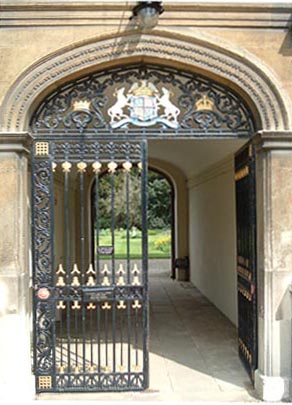
Library Visits:
- University Library
- Pembroke College Library
- Newnham College Library
- Norwich Millennium Library and Cathedral Library
- Judge Business School Information Centre
- Peterhouse Libraries
- Scott Polar Research Institute Library
- Anglia Ruskin University Library
- Churchill College Archives Centre and UL Rare Books Room
- Lambeth Palace library
- Institute of Chartered Accountants of England and Wales
- London Library
- Emmanuel College Library
- Christ's College Library
- St John's College Library
- Trinity College Library
Training Opportunities:
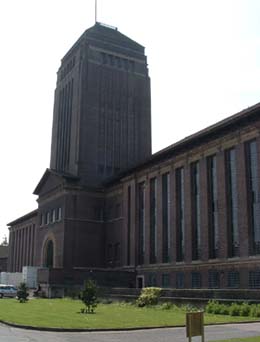
- Introduction to MARC21
- AACR2 training
- Introduction to Library of Congress Subject Headings
- Voyager Circulation Client
- Voyager Cataloging Client
- CaTaLOG website training
- Bloomberg and Datastream at Judge Business School Information Centre
- Various html/computing courses, available through the University Computing Service
- Oxford and Cambridge College Librarians' Conference
Library Visits
University Library
Our first official Graduate Trainee event together was a tour of the Cambridge University Library on 18th October. We met after lunch in the UL's Entrance Hall, and it was lovely to have the Anglia Ruskin trainees, Sarah and Richard, with us as well.
Liz was our guide for the afternoon, and she herded us very capably through the labyrinthine corridors. Our first stop was the newly refurbished Catalogue Hall, where we had the opportunity to look at some wonderful old card catalogues and guardbooks containing information on pre-1978 material. Some of the card catalogues haven't been put online yet, so they're still the only way to find certain books. The hall also featured some new workspaces equipped with screens and groupwork areas.
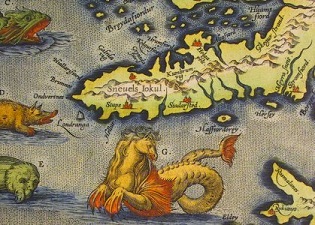 |
| Islandia. Extract from Abraham Ortelius' map of Iceland published ca. 1595. Altas.3.59.1(98). Courtesy of the Maps Department |
We were taken from here to the Legal Deposit department, to marvel at the towering piles of books and serials waiting to be catalogued (over 100,000 every year!). As one of the UK's six legal deposit libraries, the UL is entitled to claim copies of material published in the UK up to one year after publication. The Agency for the Legal Deposit Libraries manages this process for all the institutions besides the British Library, liaising between publishers and libraries. One of the things that really fascinates me about this process is the completely indiscriminate way in which the UL receives materials - they keep everything, and it really does provide such a wonderful sample of cultural production at a particular time and place. Once they arrive at the UL, materials are sorted into various categories to help facilitate the cataloguing process, and we were a little saddened to see that 'Bathtime Fun! With Peter Rabbit' was not on the high priority shelf!
From the Legal Deposit department, we went to the Map Department, where Andrew Alexander, the deputy head, talked to us about the UL's unique and extensive collections. We were given the opportunity to look at all kinds of different maps, from some beautifully illustrated 16th century ones, to a remarkably detailed map of Cambridge from the 18th century (little has changed), Ordinance Survey maps from the 19th century, through to really modern maps made with the aid of GIS (Geographic information system) technology. We were told about the history of mapmaking, and of the impact of the digital age on the world of maps. It was also really interesting to hear about the economic and political issues influencing the acquisition and drawing of maps - the Map Department aims to have maps of the whole world to a scale of 1:250,000, though there are parts of the world (such as North Korea, or rural India, for example) where such a level of detailed mapping is tricky to acquire.
Sadly, we didn't have the time to go up the tower - an experience previous trainees have spoken glowingly about! I suppose this just means we'll have an excuse to come back another day, and I'm sure we'll be back in the UL before too long.
YiWen Hon, October 2012
^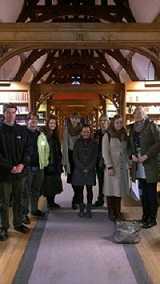
Pembroke College Library
Following our talk on library school applications, we had a short tour of Pembroke library, during which I desperately attempted to remember and impart interesting facts about
Alfred Waterhouse, Ted Hughes, and Pembroke's impressive collection of stained glass, and hopefully managed not to bore the other trainees to death.
We also took the opportunity to immortalise the occasion with a photograph in Pembroke's rather splendid Upper Reading Room.
Rachel Chanter, November 2012
^Newnham College Library
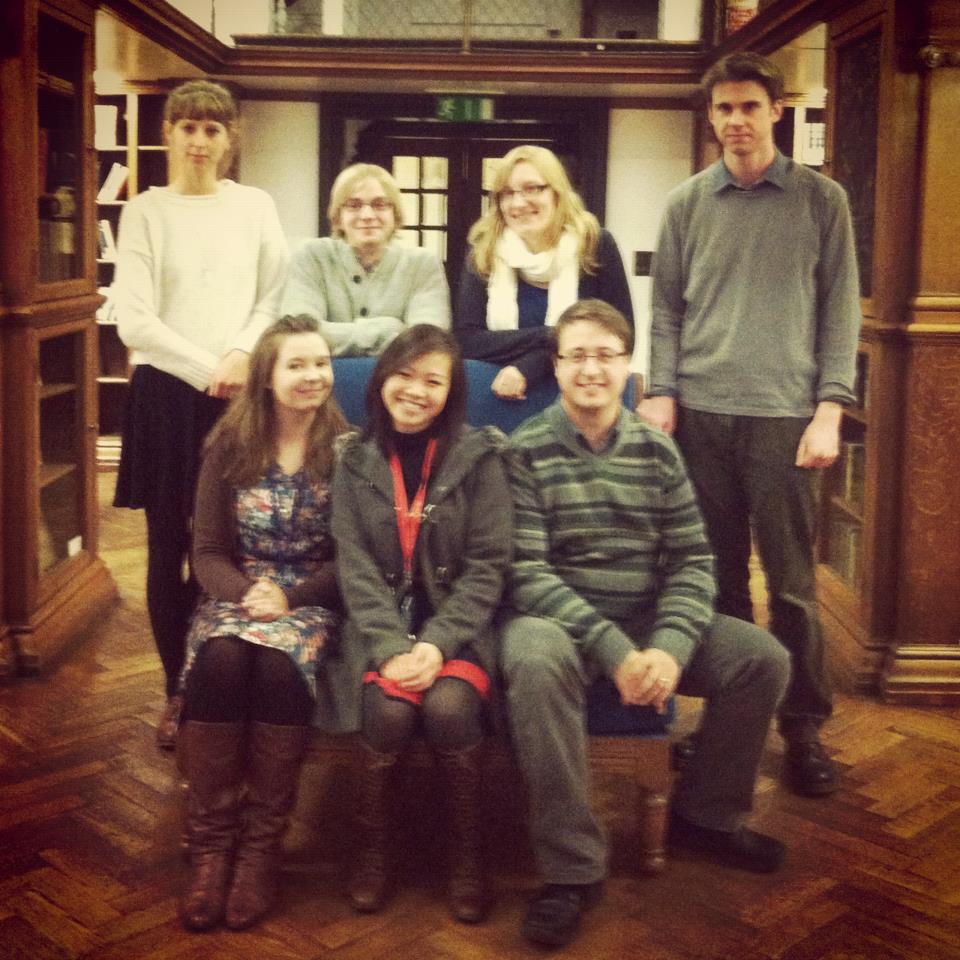
After our training session on how to maintain the CATALOG website, we were given a tour of Newnham College Library by Kirsten. Many of us were amazed by the size of the library, with its student reading space spanning three floors. It was interesting to see how the old library blended into the new space, with lots of interesting small displays on the way round the library, based on special items in the collection, such as works by Dickens and Virginia Woolf, and some beautiful examples of children's literature. Kirsten was proud to show us two exhibitions in the library, one of which displayed scrapbooks and journals of Newnham alumnae.
After managing not to lose any members of the group on the way round, and overcoming any fears of heights on the
balconies, we were also delighted to see the rare books room, in which Charlotte Bronte's ring was waiting for us
to admire. Perhaps the highlight of the visit however, especially for certain members of the group, was a visit to
Gladstone's tree (donated by Gladstone, taken from his garden), which was the cherry on top of a lovely visit, and
a nice reward after the IT training!
Philippa Bell, December 2012
^
Norwich Millennium Library and Cathedral Library
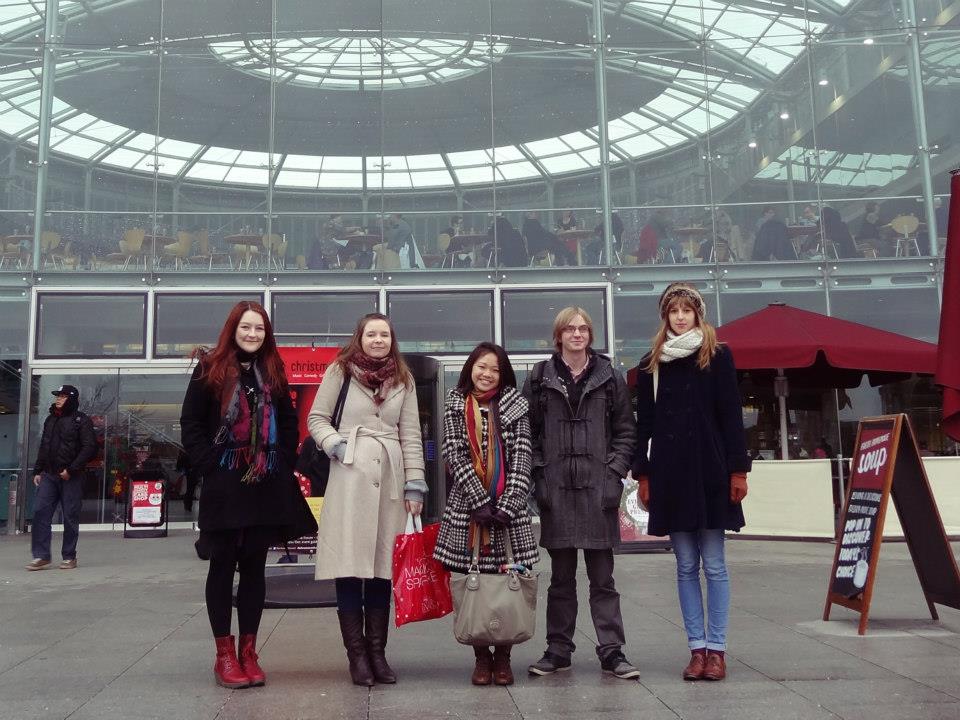
We hopped on the 9.13 train, full of hope for the day ahead. Sunshine soon turned to dark clouds and gentle showers but that didn't spoil our collective mood. After an hour and a quarter of chatting and laughing, we arrived in Norwich. Thanks to Rachel and YiWen, our fearless navigators, our march up to the Millennium Library didn't take too long and we presented ourselves five minutes early for the tour.
Catherine Wymer, the Locality Manager, was kind enough to show us around such a busy and bustling library. We found out that it is the busiest public library in the UK! It was particularly amazing to see the figures that corresponded with the title; they had almost one and a half million library users who passed through the doors during the last year. I especially enjoyed hearing about the community outreach that goes on every week with activities such as Knit and Natter and sessions for babies and toddlers. It was fascinating to get a sense of the public library world.
After a quick photo with the impressive Forum building in the background, we headed off to Norwich Cathedral for lunch in the gorgeous refectory, and had a tour around the building itself. The Librarian, Gudrun Warren, offered us a warm welcome as we entered the stunning library. It is positioned over the cloisters of the cathedral and as a result, has the most wonderful structure. The rooms filled with books seemed to go on forever in every direction! Their historic collection was such an aesthetic treat that some of us didn't want to seem to leave. We got a wonderful insight into the way in which the library operates, with Gudrun and her team of ten or so volunteers.
The trip was extremely worthwhile in giving us a sense of the various roles that librarians take on. I think each of us found ourselves more sure of the type of working environment that would be right for us.
Kirsten Southard, December 2012
^Judge Business School Information Centre
Having signed up for a training event at the Judge Business School, I thought it would be a good idea to combine my visit there with a tour of their Information Centre. Polly Harper, the 2011-12 trainee at Newnham, is currently working there on maternity cover, and she kindly agreed to show us around. Pippa and Rachel joined me on this tour.
The Information Centre is quite small in terms of its physical space and paper collections. The real strength of the JBS library lies instead in its excellent user services and impressive range of online resources.
I was really impressed by the way in which staff put a lot of effort into cultivating good relationships with their library users. For example, staff members are assigned particular groups of students and keep track of their deadlines or ongoing projects; this means that they are able to tailor services to meet students' needs accurately, and retain good, personalised communication with them. The JBS library team also run a wide range of different training events, covering traditional 'library' topics such as how to use particular databases, as well as more general career-enhancing skills like Twitter and Powerpoint. They have a great online presence, with over 600 followers on Twitter and an active, interesting blog.
I think it is lovely that the non-academic needs of students are also catered for; there is an impressive and fast-growing collection of DVDs in the foyer, and a little 'relaxation' corner with puzzles and comfortable chairs. The plasma screen displays are also kept fresh and interesting through the implementation of different themes, like the Muppets, or Star Wars!
All in all I thought the JBS library was a real breath of fresh air, and I thoroughly enjoyed my visit there.
YiWen Hon, December 2012
^Peterhouse Libraries
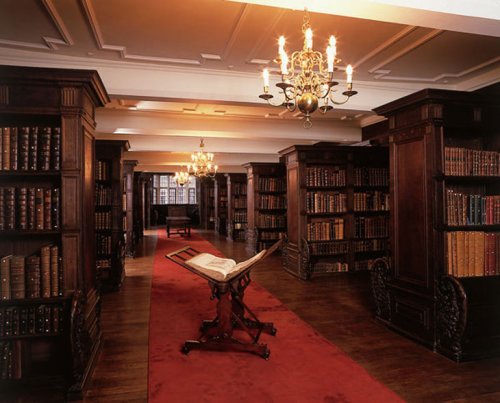 |
Perne Library - image courtesy of the Peterhouse Website |
In the last week of term, as things wind down for Christmas, I was lucky enough to be invited to Peterhouse by the lovely librarian Erica McDonald for a tour of their libraries. I had a personal reason for being enthusiastic about the visit that wasn't strictly library-related; a hero of mine, the naturalist writer Roger Deakin was a member of the College in his undergraduate days. Being, however, rather anti-establishment, Deakin's estate hadn't donated any of his papers to the College, but the librarian had created a lovely display of his printed works to tempt students into some recreational reading.
The Ward Library - the main undergraduate resource - occupies a building that was used for a century to house the Museum of Classical Archaeology, and still retains many of its magnificent classical and gallery features in the form of pillars, archways and glass-panelled ceilings. It has recently been extended further with the construction of the Gunn Gallery, which utilises the last unused museum gallery space. The room was adapted by architect Tristan Rees Roberts, who has worked on many College development projects, in a design which meshes seamlessly with the older parts of the library, echoing the design features of the original library in its mouldings, bookcases and mezzanine level. Once upstairs on the mezzanine level, the architect's clever use of space becomes apparent as it contains a surprising number of cosy nooks and crannies which the library team have taken care to make inviting to students, and houses more books than seems possible at first glance. It was both interesting and instructive to talk to the librarian about the design process of the new reading room, and the ways in which the needs of library users - both practical and aesthetic - had been considered in the new design.
I was extremely lucky to also be treated to a look at the library's special collections and archives, housed partially in the old law reading room of the Ward Library but also in the richly atmospheric Perne Library. The Perne, now a research facility only owing to the fragile and valuable nature of its collection (making me doubly lucky to have the chance to see it!) was an especially valuable and enjoyable experience for me, as was talking to rare books cataloguer Allen Purvis, who was kind enough to show me around and tell me about the various aspects of his job. It was extremely helpful to get a first-hand insight on how rare books cataloguing differs from the more day-to-day kind we trainees engage in, particularly since special collections is an area of librarianship I am eager to learn about. The low-ceilinged, dark wood-panelled, red-carpeted room is an impressive yet intimate space and earned the top spot on my list of 'favourite libraries in Cambridge', although there are still plenty to see! I feel incredibly lucky to have had the opportunity to visit this and so many other diverse and interesting libraries as part of my traineeship.
Rachel Chanter, December 2012
^Scott Polar Research Institute Library
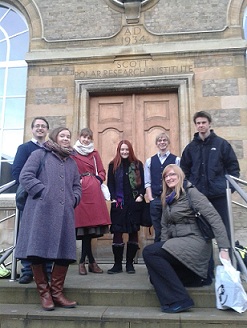
Above the museum, past the ship's bell in the corridor, we found the Scott Polar Research Institute Library. Though hidden away, the library is quite expansive, having been extended several times. On entering we were whisked away in spirit to the polar regions, surrounded by artefacts from previous expeditions to the polar regions, models of ships, and items with a link to polar research. From the very beginning we were captivated by all there was to see and hear about.
The Librarian and Keeper of Collections, Heather, and the Senior Library Assistant, Georgina, gave us a fascinating insight into the day-to-day workings of the SPRI and its library, including poets in residence, researchers from around the world, and the dedicated team of staff which maintain the world's largest and most comprehensive polar Library and Archives. Looking beyond the heart-wrenching stories of the famous expeditions such as those of Scott and Shackleton, we were surprised by how much variety and cross-disciplinary material the library had to offer, particularly the extensive range of Russian material, the largest collection outside of Russia!
Though most of us began the afternoon having only heard of the Scott, Shackleton, and the polar regions, we left feeling enlightened, inspired, and feeling that we had learned a lot, about the collections and the history behind them, and what it takes to work in such a specialist library that holds such global importance.
Philippa Bell, March 2013
^Anglia Ruskin University Library
Whilst our Cambridge college and faculty libraries are undoubtedly wonderful, I think it is important to acknowledge that they are not representative of academic libraries in general, and instead occupy a very specific niche within the sector. Our visit to Anglia Ruskin University Library was an eye-opener and served as a good reminder of what the average university library is like, outside of the Oxbridge bubble.
There are two trainees at Anglia Ruskin, Richard and Sarah, and they were our hosts for the afternoon. We began with a tour of the library building, which is zoned to allow for students' varying working habits. The ground floor was very busy and noisy, featuring quick-stop computers, group work areas, and enquiry points; the level of activity dropped significantly as we progressed up through the building to the silent study areas.
ARU's Library underwent a major restructure focusing on the improvement of customer service over the summer of 2012. This has meant an increase in the number of information assistants and the consolidation of library and IT enquiry points, with Academic Liaison Librarians instead spending more time on maintaining good relationships with the faculties and departments that they support.
I was particularly impressed by the range of different services available to students, such as the Skills@Uni workshops covering topics such as reference management software, referencing systems and database searching. The range of communication options was also good, as Anglia Ruskin offers not only traditional email, phone and face-to-face enquiries, but also a chat service and a feedback blog that appears very popular with students.
As with most other library tours, our visit was rounded off with tea and biscuits, and we had the opportunity to meet other members of ARU Library staff and talk to them about their day-to-day activities. Overall we had a very enjoyable visit - many thanks to the lovely staff at ARU for their time and hospitality!
YiWen Hon, March 2013
^Churchill College Archives Centre and UL Rare Books Room
On 19 March, the graduate trainees embarked on the latest episode of their year-long Grand Tour of the libraries of Cambridge and beyond. The first port of call today was slightly different to the usual library fare, however. Founded in 1960, Churchill College is now world-renowned for its specially-built Archives Centre, which, besides housing the papers of the illustrious Prime Minister, in whose memory the College was erected, also holds archival material relating to over 600 other figures from the worlds of twentieth-century politics, diplomacy, science and the military. We were fortunate enough to be invited to visit this wonderful resource, where we were ably shown round by the two incumbent (archival) graduate trainees, Philip and Francesca.
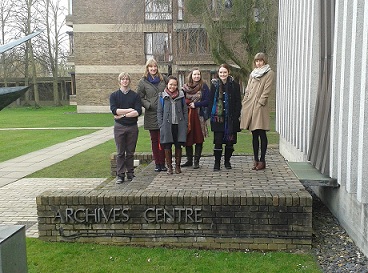
I think I can speak for all the trainees when I say that we were hugely impressed with the building and facilities at the Archives Centre. The readers ' area, capable of catering for up to six scholars at any one time, offered an airy and pleasant working environment, with a member of staff constantly on hand to field enquiries and offer assistance. Delving behind the scenes, the sheer size and scale of the strong rooms housing all the papers was astonishing, whilst any material requiring conservation was handled in-house via the Centre's special conservation studio. Several particularly interesting items had been very kindly put out for us to look out, and, regardless of political sympathies, I think the sight of Baroness Thatcher's handbag and the bronze cast of Sir Winston Churchill 's hand will live long in all our memories!
If all this wasn't enough, we followed up our visit to Churchill with a trip to the University Library 's Munby Rare Books Room, where we were given a very informative and interesting talk by the Rare Books Specialist William Hale. It was fascinating to learn how such a rich and varied collection had developed over the years, as well as the plans and strategies in place to ensure that it remains one of the foremost academic resources for the study of early printed material for years to come. To finish the day, we had a brief tour of some of the Rare Books' stacks, which provided yet another insight into some of the knotty issues of space management which in one way or another appear to confront every library!
James Smith, March 2013
^Lambeth Palace Library
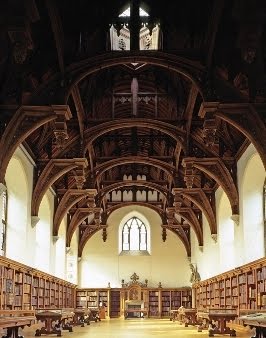 |
Lambeth Palace Great Hall. |
The 8th April was the auspicious date set for our first Cambridge Graduate Trainees visit to London, and our schedule was certainly one to pique our librarianly curiosity. With three library tours planned for the day - Lambeth Palace, The Institue of Chartered Accountants and the London Library - we had our work cut out for us, but were eager to what each library had to offer. First on the agenda was a visit to the library of Lambeth Palace, seat of the Archbishop of Canterbury and only recently vacated by the former Archbishop Rowan Williams (whose new home is, of course, Magdalene College, Cambridge). Lambeth Palace Library has a suitably impressive history and correspondingly weighty collection dating from the 9th century to the present day. Founded in 1610 at the bequest of Archbishop Bancroft, the library is the foremost repository of material relating to the history of the Church of England, and also holds the official papers of Archbishops past.
We were met by deputy librarian Hugh Cahill, who was our guide for the morning, conducting us through the numerous doors and passages which connect the various parts of the library, and explaining to us the more practical aspects of an historic library; user handling, security, shelving and storage issues etc. The magnificent Great Hall with reproduction Gothic hammerbeam roof was certainly highlight, and worth enduring several chilly minutes (enormous fans operate in the hall to maintain a suitable climate for the books still housed there) to hear its colourful history - a good old Cromwellian ransacking during the English Civil War and some substantial bomb damage in World War II. I think we were all please to discover another Cambridge connection with the Library at Lambeth: the entire collection was sent to the University for safe-keeping during the time of Cromwell's reign.
An extremely pleasant walk around Lambeth's beautifully tended gardens to view the site of the proposed new library was followed by an ever-welcome coffee and biscuits reception in what was once Cardinal John Morton's audience chamber - a room with possibly some of the best views in London, overlooking the Thames and Houses of Parliament. We were treated to a hands-on showcasing of a selection of books from the collection, including a book whose binding was stamped with the crest of Henry VIII and Catherine of Aragon, and a prayer book for missionary use, written for the 'Eskimo peoples' of Hudson Bay in an alien-looking language of symbols that could have come straight out of a sci-fi movie. We also had the chance to chat with library staff about their experiences as librarians, something we trainees are always keen to do.
We had a busy afternoon ahead of us, so we said goodbye to Lambeth and moved on to our next visit.
Rachel Chanter, April 2013
^Institute of Chartered Accountants of England and Wales
Our second visit of the day on our London libraries trip was the Institute of Chartered Accountants of England and Wales. Upon arrival we were shown into a luxurious cafe area, which led into the business centre. The library in the ICAEW seemed rather small at first, with more space for computers than open stacks; this helped us to realise rather quickly that the focus here was on the members of the Institute (and other non-member library users) and their immediate needs, and for that purpose the space was used very efficiently and the library was a very welcoming and accessible area.
We were given a quick tour of the business centre as well as some key areas in the rest of the Chartered Accountants' Hall, such as the grand reception rooms, one of which was formerly the library. Following the tour, we proceeded to an executive meeting room, where, once supplied with the all-important afternoon tea and coffee, we were given a series of short talks about key aspects of the library and its role within the ICAEW
.With most of their books in offsite storage, twice daily fetching is needed for requested books, with an additional service of 'document delivery' - posting books externally to members. The enquiry desk seemed to be the hub of the business centre, and member enquiries appear to influence greatly the work that is done in the library to improve the service. During the boardroom talks we were told about the library website, which contains around 2400 pages, all tailored around the needs of the members, with additions mirroring member enquiries; we also learned about the library customer service management system, as well as the library's marketing strategies, and the good old traditional cataloguing. Interestingly, the cataloguers also write abstracts for journal articles which they consider to be of interest to users.
All in all, the staff and space which make up the ICAEW library and information service show that they aim to make life easier for their members, and their strategies seem to work well - we were all very impressed, even those of us who aren't particularly interested in this kind of librarianship. The visit was very interesting and a real eye-opener, and the library a great advocate for private sector librarianship. Our thanks go to the staff who took time out of their busy schedules to show us around and talk to us about their work.
Philippa Bell, April 2013
^London Library
 |
Bookstacks at the London Library. |
The London Library (www.londonlibrary.co.uk) was our third and final visit of the day, and it was very kindly organised for us by Steven Archer, Assistant College Librarian at Christ's College and former graduate trainee at Trinity. After successfully navigating the tube at rush hour, as well as the hordes of tourists in Piccadilly Circus, we found the library tucked away in a surprisingly quiet and green corner of the city.
Sarah Hume, one of two graduate trainees at the London Library, met us at the entrance, and was our guide for the evening. I'm glad she was with us, as without her we would probably still be in there, wandering the stacks for perpetuity! It is such a maze of a place, even more confusing and labyrinthine than the UL. Because of the way it has expanded gradually over the years, adapting and stitching together existing buildings to suit its needs, it has a haphazard feel, and every door we opened seemed to lead to a different style of architecture altogether. It truly needs to be seen to be believed - to join one of their free guided tours, click here
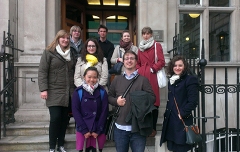
The London Library was founded in 1841 by Thomas Carlyle. Unable to borrow books from the British Library, he founded his own subscription library as an alternative with the support of eminent Victorians such as Thackeray, Gladstone, and the Earl of Clarendon. One of the founding principles of the library, still followed today, was that no book should ever be discarded, and this policy has meant that the library's collections are particularly eclectic - you never know what you're going to find on the shelves! Its classification scheme is also wonderfully idiosyncratic, with 'Cheese' sitting comfortably next to 'Chemistry'. Books are literally stacked from floor to ceiling, and I think the fact that the bookshelves are in places integral to structure of the building itself really encapsulates the ethos of the place. Because the London Library is a subscription library, it presents a unique set of challenges and has a different feel to it from any of the other libraries I've been to. I was pleasantly surprised by how busy it was on a Monday evening as there were hardly any spare seats, and the entrance hall was bustling with activity.
We finished our tour tired but happy. In one day, we'd seen three completely different libraries - Lambeth Palace, the ICAEW, and the London Library. The range of different sectors available to us as librarians-to-be is really inspiring, and I think we all returned to Cambridge excited by the opportunities that lie ahead.
YiWen Hon, April 2013
^Emmanuel College Library
It was a lovely sunny afternoon when we visited Emmanuel College Library, and our guide Tim was as bright as the sun. We were only a small group, which meant that the visit could be more relaxed, and we had time to see the various areas of the library at our own tempo. Tim had all the facts and figures about the college and the library ready to impress us with, and as we crossed the college to the library site, we were impressed, especially by how peaceful the college grounds were, just off the busy main road! The library at Emmanuel is an unusual mix; the original old library was in an older part of college, which was formerly the chapel, and is now a function room. Following that, the 'new' old library is an impressive building which was converted to be the library in 1930, with an extension added in the 1970s. In recent years, a large renovation project has taken place, extending further to give more all-important reader spaces, and giving the library a new lease of life. The old and new sections combine surprisingly well; the old rooms give an air of grandeur, and merge into the more modern, minimalist areas which provide a peaceful study space with light pouring in from every side, and plenty of room to stretch! It was nice to see that the students had a room in which they could relax and take a break from study too.
One thing we were astounded by was the size of the library - the extension spans four floors, and there are many separate rooms between the old and new sections - an exhibition space (where we saw a display put on by Tim featuring some archival treasures) accompanies some special collections rooms, which house names collections from former members of college. Sadly we were unable to go into these rooms, but they looked nice through the window! The transition between old and new was made ever clearer by seeing the work being done to install RFID (radio-frequency identification) in the college library. This is a project with which Tim has been heavily engaged, and which will bring the library up to date technologically. An increasing number of libraries are switching to RFID systems, so it was interesting to see briefly how the process works; tagging every book in the library seems no mean feat! Thank you to Tim for a fascinating visit.
Philippa Bell, April 2013
^Christ's College Library
I was pleased to finally visit Christ's College Library. Emmanuel and Christ's are neighbouring colleges, with so much in common that at one time a merger was mooted. Or so I'm told, at least. Whilst no-one's talking about such extreme measures anymore, the two colleges have a shared history, and I'd been looking forward to having a good look round.
James showed us the undergraduate library, which, TARDIS-like, is much bigger on the inside than it seems from the outside. Also, TARDIS-like, it's blue. James then took us round the Old Library, which houses around 25,000 rare printed books and manuscripts, many of them in beautiful oak bookcases built in the late-nineteenth century to match their original seventeenth-century counterparts. Amongst this collection were works of former members, including first editions of Paradise Lost and On the Origin of Species. James writes a very interesting blog about some of the treasures in Christ's collection, which you can visit here.
Finally, James took us 'behind the scenes', where there is an awful lot of work being done cataloguing and conserving the books that didn't make it onto the more glamorous shelves. Here we found the safes that James had told us so much about, and confirmed that, yes, if they hadn't been so full of rare manuscripts it would be possible to climb inside.
Back in the early days of the traineeship, visiting another college library was exciting because it meant seeing a grand old building, and I would imagine what it would be like to be a trainee there. But now I feel I'm also able to start to think critically about what it would be like to work there full time. As well as quizzing James about the library, we were interested in the staff structure, the relationship between the library and the College, and the professional standing of the staff. The year has been flying by, as I knew it would, and thanks to all the visits, conferences and training sessions we've packed in I feel that I'm in a much better position to judge where I would like to be working this time next year.
Tim Halpin, April 2013
^St John's College Library
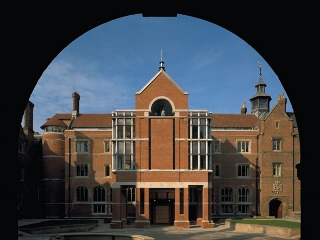 |
The Working Library at St John's |
I think we were all glad that YiWen had come outside to meet us, as the great wooden door to St. John's college library looked quite a feat to open. We were impressed by the spacious student library, which spans four floors and has lots of nooks and crannies to hide away in and immerse oneself in study without being disturbed (or, in the Audio Visual room, watch an episode of something, or a film, in peace and quiet). The reading areas are light and airy, and many desk spaces have impressive views over the college grounds - perhaps sometimes a welcome distraction! The library also has a relaxed attitude towards food and drink, and even has a vending machine for a certain well-loved brand of chocolate, which I imagine the students must appreciate. With a large body of staff each with individual responsibilities but all willing to muck in together when necessary, it seems that the library runs well on a day-to-day level.
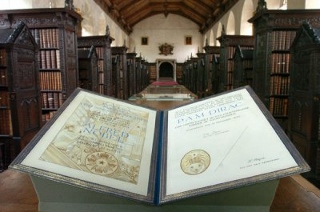 |
The Old Library at St John's |
Once we had seen the student areas, YiWen took us, via the exhibition area, to meet the Special Collections Librarian, Kathryn McKee, as well as Rebecca Watts, who is working on the Samuel Butler Project. We were very interested to hear about this unique project, which revolves around the life and work of a former Johnian from the Victorian era. We were given a sneak peek at some of Butler's photographs of everyday life, including a staff favourite - sheep on a ship! Following on from this, we were led into the two-storey 17th century Old Library, where the college's early printed books, manuscripts and college member records are kept. The upper room sees many visitors over the year, and proves popular with school groups. The impressive stained-glass windows lit up this magnificent room, and the ornate bookshelves gave it a grand air. We enjoyed looking through astronomer Fred Hoyle's telescope and glancing at some of the adorably tiny books in the collection.
Finally on our whistle-stop tour around the library, after having talked to some other members of staff about their roles, we popped into the biographical office, where Fiona Colbert, the Biographical Librarian, told us about her work, finding and providing information about former members of college during and after their time at St. John's, which sounded like a very busy but fulfilling job! After having seen the key areas and learned a great deal about the function of the library, we gratefully welcomed tea and cake, and a bit of a rest before the next visit! Many thanks to YiWen and the St. John's library staff for taking the time to show us around and tell us about their work.
Philippa Bell, April 2013
^Trinity College Library
Before Pippa took us in to Trinity College, I had never dared to step inside. Even as a member of the University, I felt concerned that I would be mistaken for a tourist by the very smart-looking Porters standing outside. But guided by Pippa, I discovered that the college is as gorgeous and grand on the inside as its facade.
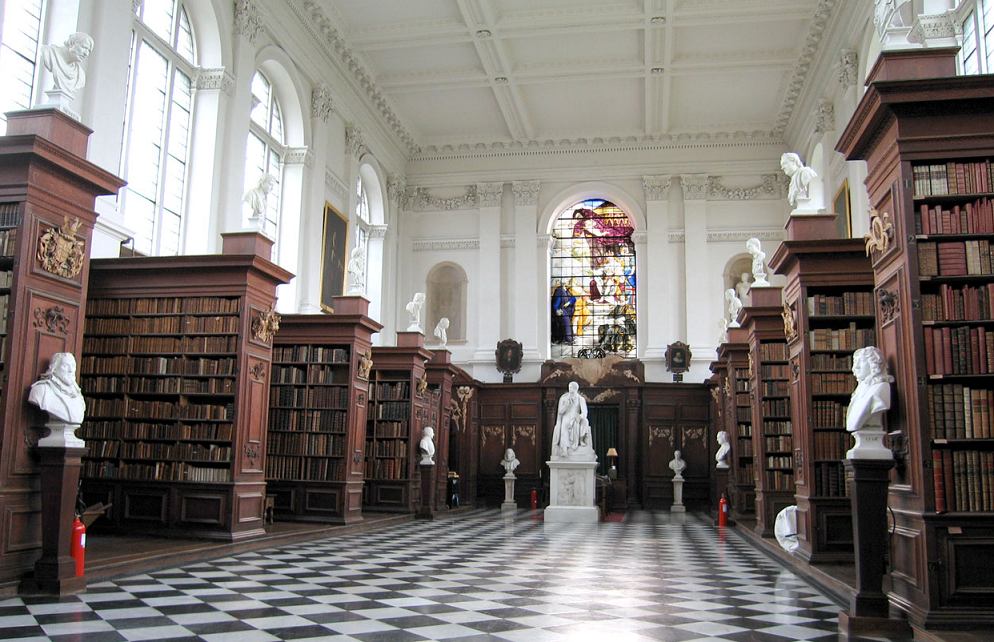
In the student library the exam stress was already tangible, although it was a few days away from the offical start of term. Almost each desk was occupied with a student surrounded by their books and papers. We were as quiet as possible as Pippa showed us the office, the periodicals area, the various study areas and explained their classification system. It was really interesting for me to learn how a library with a large number of staff functions, as I am part of a team of three. A rostering system for Wren library duties, issue desk and a number of other roles is a big factor in the day-to-day running of library.
After seeing the student library we were taken in to the Wren Library, designed by Sir Christopher Wren. To say it was a joy would be an understatement! The building is absolutely amazing, with its high ceilings and huge windows. The ornate wood carving along the book cases and wood panelling was of particular interest to me. While cataloguing art books a week after the visit I spotted carving that looked very similar on a dust jacket. It happened to be a monograph on the artist Grinling Gibbons who designed and executed the carving!
Pippa was kind enough to show us a selection of the special collections housed in the Wren. The treasures were never ending! We were lucky enough to see one of the notebooks of Sir Issac Newton, several illuminated manuscripts and a John Milton manuscript to mention but a few! On display in the cases were other treasures of the collection - notably, AA Milne's Winnie the Pooh manuscript! Looking at it brought back so many happy memories.
It was a really interesting tour, giving me an insight into the workings of an older and larger Cambridge library. Now that I've stepped inside the college once, I'll definitely be visiting again!
Kirsten Southard, May 2013
^Training Opportunities
Introduction to MARC21
MARC 21, more than AACR2, was a thing that struck fear into my heart when I started working at Newnham Library. Library staff mentioned it as though the reference should be understood by all in the Library and Information Studies world but for the first few weeks of my training, I was utterly baffled by it all.
Thankfully, Pete Girling was there to come to the aid of all us graduate trainees. Over three mornings on the week of the 24th of September, we gathered in the University Library to learn about the ways of MARC. The learning curve was steep, but it was nice to get a handle on something that had seemed insurmountable. We progressed through the coding fields at a steady pace, and all our AACR2 training seemed to come together and make sense (although, of course AACR2 will be replaced by RDA at some stage soon…).
The graduate trainees all went for a drink on the Thursday evening to celebrate our MARC21 competency - not a mean feat! Although I haven't had a chance to do much cataloguing as of yet, I'm looking forward to putting my training to good use! Hopefully during the Michaelmas holidays there will be more of an opportunity for this!
Kirsten Southard, October 2012
^CaTaLOG website training
In order to maintain and contribute to the CaTaLOG website, we trainee freshlings had to partake in an HTML course run by the University Computing Service, and then attend an afternoon's training on our website in particular, run by Colin Higgins. Colin was an excellent tutor, and we soon got the hang of what we needed to do - the afternoon flew by. Although the HTML codes look like absolute nonsense to begin with, our training sessions have enabled us to decipher the code, and, with computing becoming increasingly important in library work, we feel we have gained a key skill to build upon in the future.
Philippa Bell, December 2012
^Bloomberg and Datastream at Judge Business School Information Centre
I've heard great things about the training programmes at the Judge Business School through Twitter and the library blogosphere, so when the opportunity came up for me to attend a session on Bloomberg and Datastream, I jumped at it. I'm interested in exploring commercial, business, or law librarianship, so I thought this would also be a really good opportunity to build up some knowledge of relevant technologies.
Meg Westbury began the session by showing us Bloomberg. It contains a truly mind-boggling amount of economic, financial and business-related information, and although the display can be very confusing at first, watching a practical demonstration was very useful and it helped demystify the whole thing. There was quite a lot of financial jargon being bandied about, but although I may not know what the information means, this will not stop me being able to find it!
Particularly interesting to me were the supply chain and map functions; the former allows us to see the complex relationships between companies, their suppliers and distributors, whilst the latter tracks (in real time) the movement of cargo ships and their contents across the globe. Although the latter might not be particularly useful, I think it gives you a good idea of just how powerful a tool Bloomberg is, and the range of information it holds.
After a short tea break, we were then given a presentation on Datastream by Andy Priestner. Datastream is far less flashy-looking than Bloomberg; there are fewer colours and flashing things to distract you, but overall in terms of the actual financial and economic information provided I came away with the impression that both are on a par when it comes down to the nitty-gritty. It's certainly not as diverse (no news, weather or classified listings, for example), but this could certainly also be seen as a strength, if you're simply after data. Both databases also offer full functionality in terms of exporting information to Excel spreadsheets.
Unfortunately, I had to leave the Datastream presentation a little early to go to the Information Centre tour, but I came away with a good overall grasp of what these databases are capable of, and why and how I might use them in the future. I was also really impressed by Andy and Meg's presentation skills; they were clear, concise, and interesting.
YiWen Hon, December 2012
^Oxford and Cambridge College Librarians' Conference
The theme for the 2013 Oxford and Cambridge College Librarians' Conference was "Great Expectations". The call for papers mentioned a range of topics dealing with the expectations surrounding college library staff, whether those expectations came from students, Fellows or other librarians. The email specifically highlighted the organisers' interest in hearing from graduate trainees, as we're all relatively new to the college system. It was YiWen, the trainee at St John's, who suggested that we put our names forward to present. Everyone was very enthusiastic, so we set to work discussing our ideas.
The first step was to begin writing and editing the text as a group. We split the presentation into three timeframes (based around our past, present and future expectations); a number of us focused on each section. YiWen kindly edited these together and voila! Tim and I steadily worked on the Prezi (which can be found here) over a period of a few weeks. After dozens of emails, several more meetings and a final practice session the week before, we were ready for the morning of the 25th of March.
The programme was really interesting and a credit to the organisers! It included subjects as diverse as RFID systems, the joys and perils of solo librarianship and making the most of your special collections (amongst others!). We were the final act, so our speakers shuffled onto the stage somewhat nervously to present (although I was only the button presser for the Prezi). Tom, James, Pippa and YiWen presented very well - it went off without a hitch! It was safe to say that we all felt elated that all the hard work and practice had paid off.
After the fascinating morning, we were treated to a great lunch, where we were lucky enough to meet some of the Oxford graduate trainees. It was great to compare our experiences and talk about common interests. It's amazing how different each one of the graduate traineeships is, as each library focuses on specific projects or duties, depending on the strengths of the individual trainee.
Library visits followed in the afternoon. I got to see the beautiful library at Magdalene College, while others went to Trinity Hall, Christ's and Gonville and Caius College Libraries.
Although the Oxford delegates had to head home on the bus at 3.30pm, the Cambridge trainees met up afterwards to debrief and discuss all the interesting presentations. Needless to say, the conference was a wonderful experience!
Kirsten Southard, April 2012
^Details of blog entries for previous years can be found here:


